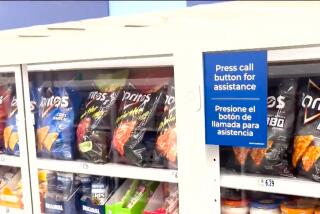Compton feeling good
For years Compton has struggled against a lousy reputation. Its name has been invoked by rappers as a euphemism for violence, rebellion and poverty. “It’s the home of the jackers and the crack. (Compton!) Yeah, that’s the name of my hometown,” sang the rapper The Game.
But these days, Compton is starting to look almost suburban.
Since last year, Staples, Target, Best Buy and Starbucks, among other national retail chains, have opened stores in the city. Although they have yet to generate more than a few thousand dollars in sales tax, the stores mean more than revenue or convenience to many city residents.
“I don’t like the idea of having to go outside of this community to spend my money,” said Kevin Love, 48, as he passed a recent lunch hour shopping at Best Buy at the Gateway Towne Center, which opened late last year. Attracting retailers has been a tough battle for Compton, since the merchants required constant reassurance of safety and success from city leaders -- and one of the most advanced retail surveillance systems in the country.
Not only does the Gateway Towne Center, which opened in October, have the type of security cameras found at any shopping center, but the L.A. County Sheriff’s Department installed its own video cameras, license-plate scanning cameras and cameras that respond to the sound of gunshots.
Live feeds from the cameras are monitored on big-screen televisions in a small room inside the sheriff’s Compton station on Willowbrook Avenue. Four deputies patrol the center full time, and a sheriff’s substation is set to open next to Daniel’s Jewelers.
“My No. 1 priority is security,” Mayor Eric Perrodin said. “I’m not going to let anyone disrupt the opportunities we’ve been given when these retailers came to Compton.”
Last month, further proof of the city’s budding revival came in the form of a visit by Prince Andrew, the stately gray-haired Duke of York, who attended the opening of a British-owned grocery store.
“Finally, we are taking the city back into our hands,” said Kofi Sefa-Boakye, Compton’s community redevelopment director.
Erma Clemons, 73, echoes that sentiment. She has lived in Compton nearly five decades and has had to plan her shopping trips for years, either stopping in Gardena or Lynwood just to buy fresh produce or basic products such as paper towels and soap.
Clemons is a proud caretaker of her city. She calls local television stations to complain when Compton is portrayed in a bad light and complains to City Hall when residents litter. For her, the new stores are an affirmation.
“Finally,” she said, “the powers-that-be understand that our money is green like everybody else’s.”
Decades ago, Long Beach Boulevard was Compton’s economic heart. So many car dealerships lined the wide street that it was known as Chrome Row. But by the late 1960s, Chrome Row was dying, with owners complaining of thefts and violence.
In the late 1970s, as a rash of businesses abandoned the city, officials invested millions in redevelopment funds to build the Alameda Auto Plaza. Even then, the city was billing itself as a “new Compton,” a community on the economic upswing.
But compared with other municipalities, Compton officials say, the city was hit especially hard by Proposition 13, which stripped the city’s tax base. The community had come to rely so much on property taxes after the decline of Chrome Row and the departure of other businesses.
And the auto plaza, mired in allegations of inept leadership and faced with competition in nearby cities, never lived up to expectations. Most dealerships failed soon after opening.
Then, when the city tried to shift its attention to attracting retail, it failed.
“People don’t want to invest in areas that are unstable, that are in crisis,” Sefa-Boakye said.
In the late 1980s, homicides in Compton averaged nearly 80 a year. In 1994, there were 90, according to the Sheriff’s Department.
In 2000, the city disbanded its Police Department to cut costs and contracted with the Los Angeles County Sheriff’s Department for 70 deputies, after being told it needed at least 100.
In 2001, Perrodin was elected mayor amid allegations of voter fraud by incumbent Omar Bradley. Bradley, who called himself the “gangster mayor,” was convicted of felony corruption charges in 2004, along with a former city councilman and former city manager.
Recently, things have calmed a bit. Homicides have dropped -- the yearly average since 2000 has been about 45 -- though Compton still has one of the highest crime rates in the nation. At the same time, developers have shown renewed interest in transit-oriented development, making Compton, which is bisected by the Metro Blue Line, more attractive, officials say.
In 2003, developer Prism Realty Corp. and Inside Quarters Enterprises, a company founded by retired football player Vince Evans, made a pitch to develop the abandoned auto plaza into the Gateway Towne Center. The plan: The city would sell them 46 acres of community redevelopment land for about $15.3 million in exchange for retail and residential development.
For many residents, the prospect of shopping at national chains in the city was enticing. There was added excitement when word got out that a sit-down restaurant might be part of the project.
One year later, Perrodin and a team of recently elected allies on the City Council agreed to the plan. But building the center required constant assurance from city leaders.
“The city leadership had to convince [developers] that we would do everything in our power to make it a success,” the mayor said.
When developers presented a final list of retailers -- which included Target, Best Buy, Home Depot, 24 Hour Fitness and Shoe Pavilion -- “we just gave our stamp of approval to it,” Perrodin said.
Local officials broke ground for the shopping center on Valentine’s Day 2007. The celebration had the fervor of a Sunday church service, with a band, numerous prayers and a hot buffet. As people shook the mayor’s hand and slapped his back, Perrodin said in many ways the biggest victory was psychological.
“This shopping center will help in the mind-set of people here, help them with self-esteem,” he said at the time. “The biggest problem we have with the people in Compton is their mind-set that nothing good can happen here or come here.”
By most accounts, the Gateway project is doing well despite tough economic conditions that got it off to a slow start, officials said. Developers are in the process of securing tenants for a second phase of the center, said Eric Eklund of Prism Realty.
Still, there is no sit-down restaurant. Developers say a lease with T.G.I. Friday’s is signed and the restaurant could open this year. A second restaurant could open during the second phase, Eklund said.
It’s the type of shopping destination that retailers look for when entering a new community, said Tom Niro, regional vice president for Staples. Before Gateway, “there was really no retail synergy there,” he said. “We’ve actually been looking forward to getting into this community for years.”
City leaders expect the center will bring in about $1.2 million in sales tax a year, but so far it’s brought in only a few thousand.
A few other development projects have also taken shape. In December, the first phase of the Willow Walk Project, a $40-million town home and retail development venture, opened with the help of city redevelopment funds.
And another shopping center, with the British-owned Fresh & Easy Neighborhood Market, is taking shape across town. A Panda Express and Starbucks have already opened.
The debut of the Fresh & Easy on Rosecrans and Central avenues was a grand affair. Prince Andrew, in a black suit and baby-blue tie, greeted hundreds of excited spectators waiting behind yellow caution tape.
“I appreciate what they’re bringing to Compton,” said Flora Ray, 68, who has lived in the city for 48 years. “All the time I’ve lived here, I’ve gone to other areas to shop.”
“We don’t have to go to another city,” echoed Ruben Hernandez, 47, a 40-year Compton resident. “We’re moving up.”
But the prince made it a quick affair. He smiled politely but made no statements outside the store before cutting a red ribbon. Then, he quickly walked over to the crowd, shook hands with a couple of spectators, ducked into a limo and rushed away.
--
Megan Garvey contributed to this report.
--
(BEGIN TEXT OF INFOBOX)
City spotlight
*--* -- Compton L.A. County Area (square miles) 10.2 4,079 Population 98,435 9,948,081 Median household income $38,682 $51,315 Families below poverty level 23.2% 12.4% Foreign born 28.5% 35.4% Median home value (2006) $372,400 $574,100 *--*
--
Sources: Census Bureau (2006 American Community Survey), California State Assn. of Counties, ESRI, TeleAtlas
More to Read
Inside the business of entertainment
The Wide Shot brings you news, analysis and insights on everything from streaming wars to production — and what it all means for the future.
You may occasionally receive promotional content from the Los Angeles Times.











